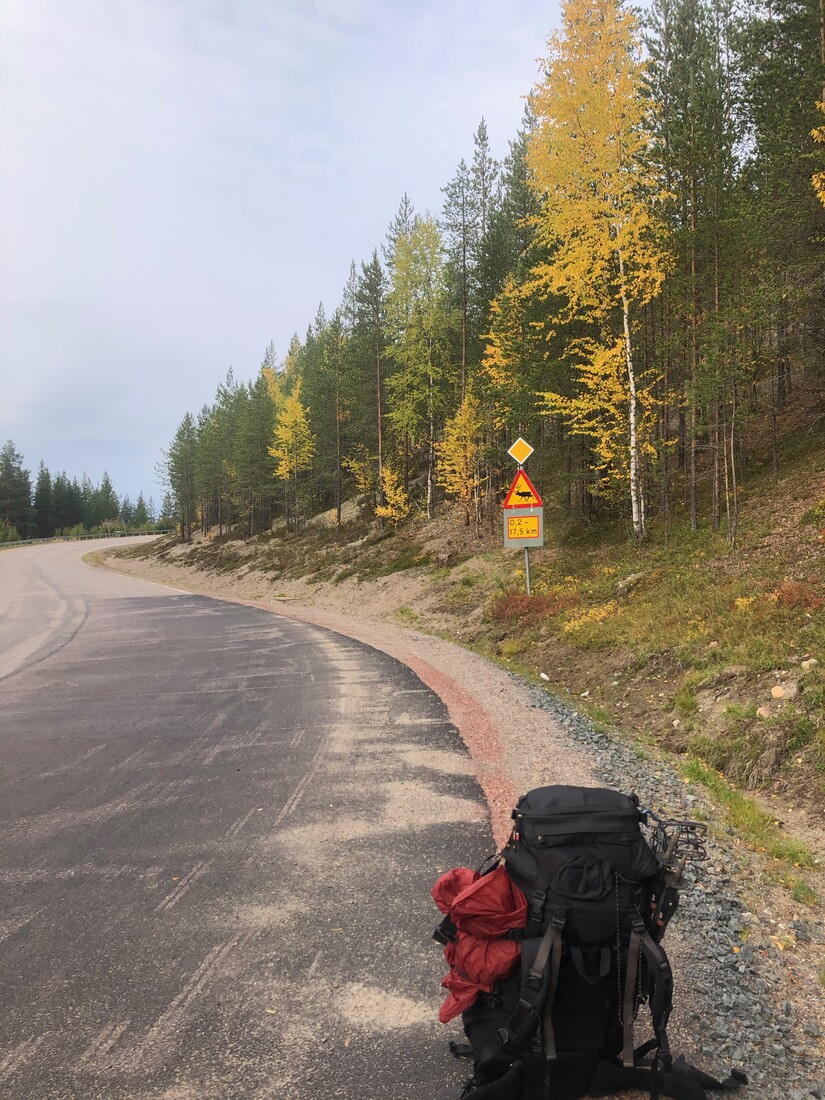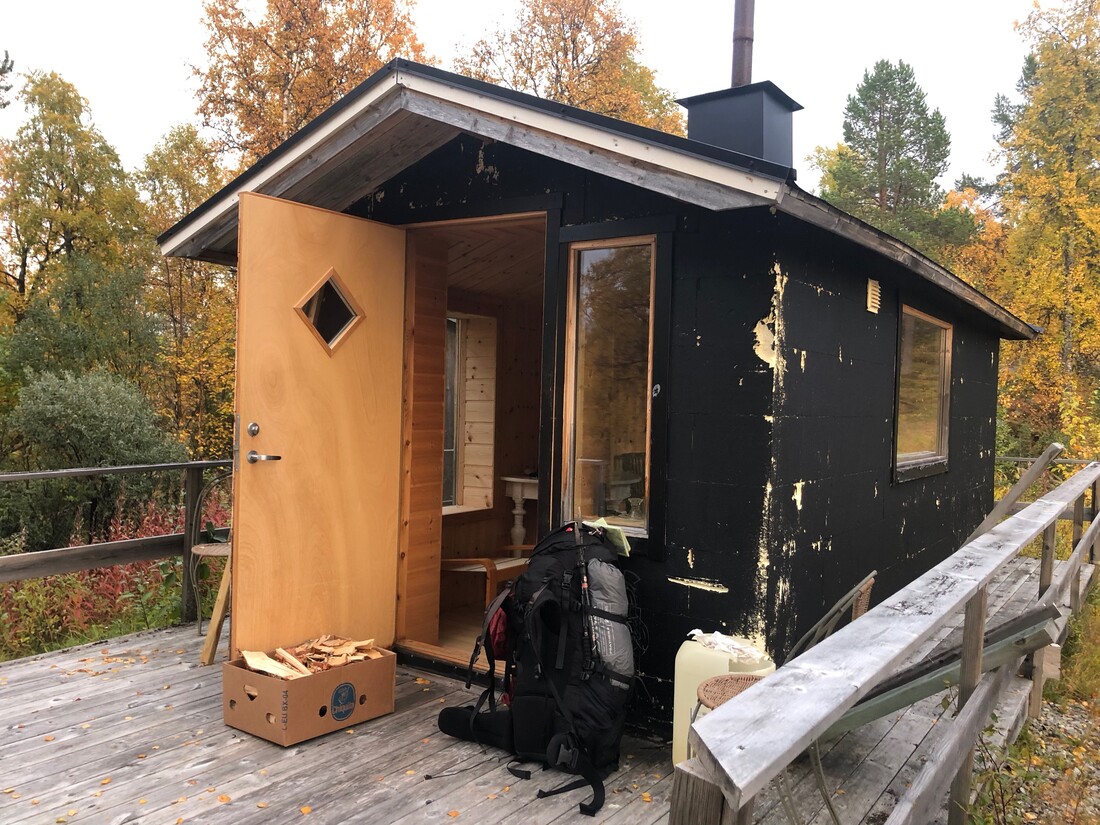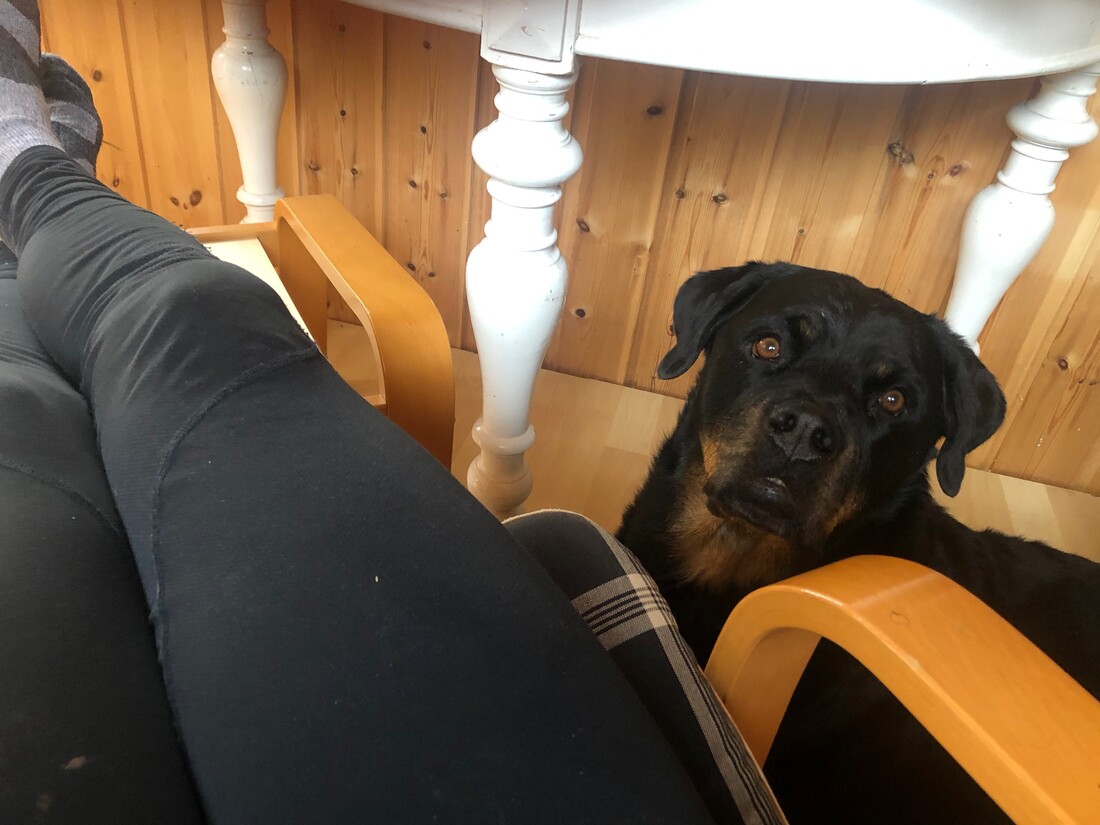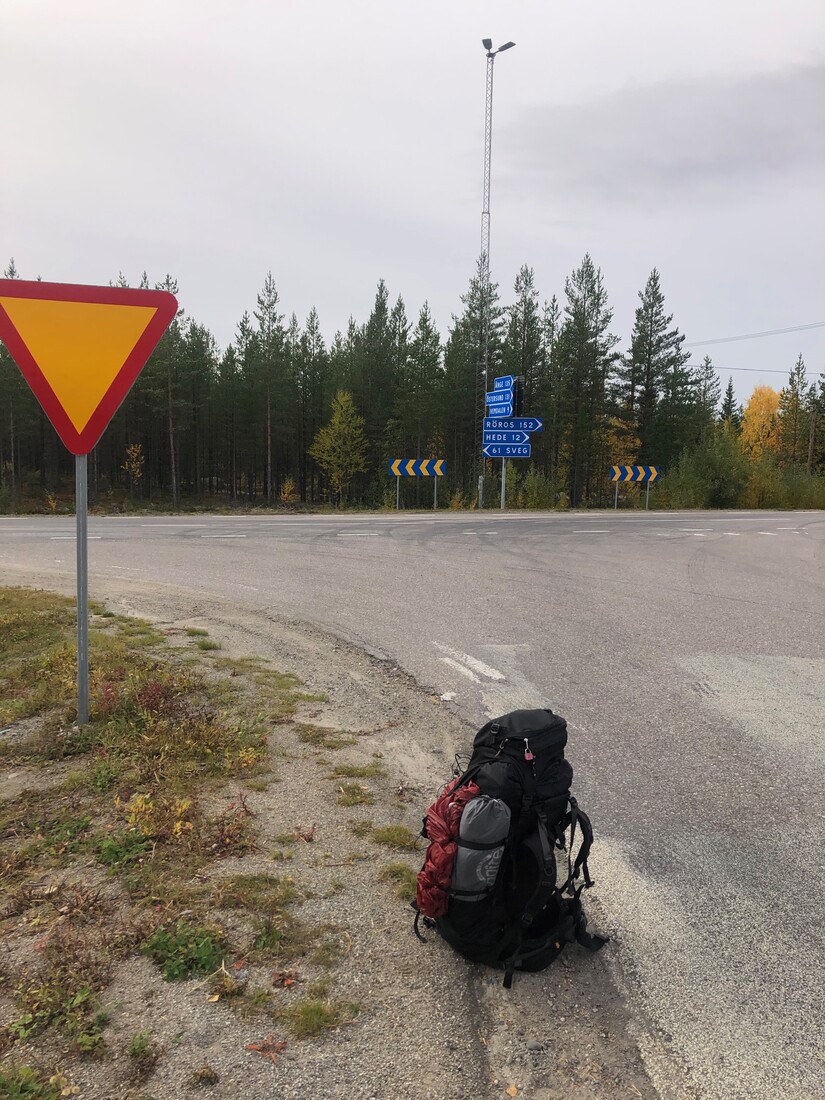No backseat in the car, I finally understood the gesture.
The two teenagers in the front of the station wagon had smiled but shrugged their shoulders. The whole rear section had been converted into a stereo, I realized as their EPA-traktor crept by at throttled speed. Lowering my thumb, I watched the stunted car drive away.
Long after the warning triangle on its rear had disappeared behind the bend, its engine and the thumping from the loudspeakers still reverberated on the wind. Pretty bassy for a castrato, I thought.
A handful of yellow leaves tumbled over the tarmac with a dry rustle, past the pole where my backpack was propped, towards the signpost at the T-junction where the country road leading out of Härjedalen ended. Above my head, the wind danced through the birch trees.
Only a few cars had passed by since I was dropped off here, deep in the central Swedish province. Waiting, I was almost to the end of the book that I had borrowed from Uppsala Library weeks before, New Print of Older Writings on Jämtland. As I looked up from its pages to the empty road, the encounters of the past days drifted through my mind.
I may have used up all my hitch-hiking luck for this year, the thought began to dawn on me.
But let’s start at the beginning.
The scene a few days ago was nearly identical. Autumn leaves, a country road branching off from the highway, a signpost to keep my backpack upright.
Waiting for a ride.

I had spent the previous three days exploring the mountains and forests around the small town of Idre, on a quest to locate a historic panorama drawn by an expedition 350 years ago. Although I had left with more questions than answers, I was in good spirits. I was heading into a landscape that was, for me, a blank page, waiting to be filled.
Warning signs on the forest roads announced the beginning of the moose hunting season in Dalarna. I’d gotten a ride out of Idre in a red jeep with gun cases tied to the roof. The brief journey lasted all of fifteen minutes. Most of them I spent at the mercy of the driver, glad of a captive audience for his impassioned soliloquy about guns and hunting cartridges, with particular emphasis on the merits of repurposed Wehrmacht rifles in bringing down the king of the forest. All delivered in thick Småland dialect.
In rhythm with my nods of feigned interest, the mantra ran through my mind: No one rides for free.
The hunter dropped me off at a junction about a day’s travel northwards from the next destination of my journey: a stone near the Norwegian border, inscribed with enigmatic characters. The mysterious antiquity had first been depicted by the same historic expedition from 1675 that had sketched the mountain panorama around Idre.
After half an hour, another vehicle stopped. Reflecting the hazy sunlight, a heart-shaped balloon escaped into the sky as the car door opened – two couples from four different countries in Eastern Europe on their way to a birthday party in Lofsdalen.
A Babylonic mix of languages filled the passenger cabin, sparkling as the rhinestone hearts on the women’s jeans – all suffused with a distinct note of hairspray. The conversation this time was less fluent, yet cordial, but most of all less ballistic. A positive trend, I concluded.
Half an hour later, I hefted my backpack out of the trunk at a crossroads where our ways parted. “This hour, not much traffic,” the Estonian construction worker warned from the back seat, pointing to the road.
I waved the birthday party goodbye, and had just taken out the library book from the front pocket of my backpack when a blue Volvo pulled over.
“I’m heading north,” I answered the bearded man in a lumberjack shirt wearing yellow ear protectors. “Towards the Norwegian border.” Some years younger than me, I estimated.
“I live about twenty kilometers up the road,” he said. “I can drop you off there.”
I heaved my backpack into the truck bed next to a row of plastic storage boxes – all empty. Between them, a rifle bag. Not again, I rolled my eyes, at least inwardly.
From between the cushions of the front seat I removed some Candy Cars that had spilled from a plastic bag on top of the glove compartment. Soft drink cans clattered as I tried to find room for my legs. Riding shotgun – how ironic, I thought as I buckled up. His eyes glued to the road, my driver returned to steering his vehicle home.
“So you’re back from moose hunting?” I eventually broke the hum of the sixth gear.
“Jau.” His voice sounded soft and gentle, with an underlying shyness.
“I noticed the season has just started.”
“Jau,” he echoed.
With my thumb I pointed back towards the empty boxes.
“So no luck today?”
“Jau.”
I noticed the rubber antenna on his ear protection quivering with the vibrations of the road as we gently ascended into the hilly region towards the border.
Is his radio still on? I began to wonder.
The villages we passed through were little more than a few houses. The population density of Härjedalen is less than one person per km². The highest village in Sweden, a blue sign advertised on the way.
Glacier-flattened mountains added some contour to the horizon in the far distance. In silence we crossed through the sea of pine trees and yellow birches that filled the plains before them, occasionally dotted with lakes and patches of marshland that were already verging towards brown.

In a curve further on, another town sign flew by. This one boasted a more cryptic claim: Kalendergubbarnas By.
“Village of the old calendar men?” I was still pondering the meaning of the words when the car began to slow down. Switching off the engine, my driver headed straight for one of the houses along the road, leaving his gear in the car. My ‘thank you’ prompted a nod and a short goodbye. Don’t think I’ll get an answer about the sign from him, I thought as I carried the backpack to the other side of the road.
A trash can lay tipped-over near the tarmac. Taking a seat, I once more reached for the book in the front pocket. Soon I lifted my eyes again, to the curiosa on the opposite side of the road.
Rusting machines and tractors, with weeds growing on the truck beds. A wild mix of Euro-pallets, discarded propane tanks, and building materials lay scattered between them. A rusting biathlon target rose from the scrap, with a few black disks stammering morse code on white ground. On top of a shed parked a vintage snow scooter, the lurid orange of its front panel shouting through the colors of autumn and decay.

It was another half an hour before the next vehicle passed by. The logging truck set the weeds across the road wavering in its wake. The fragrance of fresh wood still lingered in the air when a station wagon followed after. A friendly nod from the elderly couple inside. The Estonian construction worker had been right.
I got up from the trash can, stretching my legs and taking a few steps towards the house in Falun-red that my monosyllabic driver had entered. There were no lights on, and no smoke was rising from the chimney.
He didn’t turn his head when I passed the front window. Through the glass I spotted him sitting in a corner of the living room – ear protectors still on.
“Are you waiting for Gustaf?”
After an hour or two, I had picked up the backpack again. It was time to scout out a place to make camp. As I was walking up the road, the front door of the house next to my silent driver’s opened. A middle-aged woman with gray hair and a Norwegian sweater came out onto the porch, accompanied by two Rottweilers that gazed at me in anticipation of an answer.
“Are you a friend of Gustaf’s?” she rephrased.
“Oh you mean the guy who lives over there?” I concluded, pointing to the red house.
“Yes! I saw you through the kitchen window. We thought you are waiting for him.”
“He’s already at home. He was the one who gave me the ride here.”
“Oh right, now I see his car over there!” Then: “So where are you going now?”
“Heading for the forest. Looking for a place for the night.”
“Oh why don’t you come in first!”
I lifted the latch on the fence. The black gate swung open, drawing a wide arc over the road. The two dogs dashed forward, sniffing my hiking tights without a bark.
“That’s Scooby, and that’s Semla,” she introduced the Rottweilers. “And I’m Åsa.”
“So you’ve travelled up here from Uppsala?” Åsa later inquired over green tea in the kitchen. I nodded as I took a first sip. Indicating the book peeking out of my backpack pocket, she asked: “Doing library research down there?”
From my notebook I pulled out the printouts of the mountain panorama near Idre and the stone I now wanted to visit up near the border. And with great curiosity Åsa inquired about the 1675 expedition that had brought me to this part of Sweden.
“I suppose you know the Carolina Rediviva then?” she later picked up the library thread again.
“Indeed,” I replied. “I’ve been spending quite a lot of time in the special reading room.”
“You know Krister Östlund?”
“We had a drink some weeks ago, together with a close friend of mine who also works in the library. The two of them edit a series together of Neo-Latin texts in translation.”
Åsa threw back her head, laughing.
“That’s too funny! Krister and I used to go to the cinema a lot when I studied in Uppsala, back in the 1980s.”
Over tea, I had already spotted the historic map of Jämtland-Härjedalen hanging on the kitchen wall. After Åsa had removed the cups, we tried locating the ‘Stone in the Green Valley’.
“The next days aren’t looking too good,” she commented on my plans. “This really is the end of the season.” “There is a hut down on the lake,” she added. “Olle’s man cave. Has been his carpentry project for years. Stay as long as you need!”
In the meantime, her husband Olle had come in from his workshop. He worked jobs all across the globe, Åsa had explained before, welding anything from oil rigs in the North Sea to pressure tubes in nuclear power plants. His family had lived in this village for more than a century, she said.
As she outlined his many building projects, the archetype of a rural DIY hero materialized before my inner eye. Welding a mast for the first wind mill in the area (he had replaced the nacelle with an illuminated star several years ago), his storybook flying machines – or his impeccably carpentered ‘man cave’. “Sometimes I think he has this plan hard-wired to populate Ränningsvallen,” Åsa confided in a quieter moment.
“You’ll find fire wood in the shed over there,” Olle commented on the invitation his wife had extended. As I left, Åsa handeld me a bundle. “Here, and take some fresh eggs with you!”

On my way out the door I noticed a calendar lying on a table. Härjedalingar 2004 read the title page. The cover showed men in the second half of their lives, posing while ice fishing, welding, riding snow scooters, or leaning against snowy stacks of wood – all bare-chested.
It began to dawn on me.
“Is this what the sign at entrance to the village is about?”
“Yes indeed! We’re the proud village of the kalendergubbarna.
I raised an eyebrow.
“Back in the 2000s we were looking for a way to raise some money for a local association,” she explained. “That was about the time when the movie ‘Calendar Girls’ came out. All the gubbar (old men) of the village jumped on board when we came up with the idea of trying something similar.”
“And was it a success?”
“Quite so!” she said. Indicating that I should wait a moment, Åsa walked into the other room. She returned with a heavy folder under her arm.
“We produced the gubbkalender for more than a decade,” she said. “This is our archive.”
“The calendar was a huge hit all across Sweden,” Åsa continued while I began to browse randomly. “Some years we sold around 7000 copies.”
“One year we even had a lady from German television up here,” she added as I fished some copies from the folder. Joining me at the table, Olle picked up one of them, flipping through the pages. He eventually tapped on a half-naked man on a snow glider, taking off from a frozen lake. “That’s me!” he announced with a proud smile.
Carrying the eggs with one hand, I peeped towards the archive folder on the way out.
“Can I take that over, too?”

Two hours after I had taken a seat on the trash can at the side of the road, I found myself in a floating cabin, lifted into dry dock at the shore of the nearby lake. Placing my tired feet on a footrest, I leaned back in a comfy chair, a fire crackling in the iron stove behind.

Through a window in the paneled walls, I watched the birch trees around the lake shivering in the wind, a tail of leaves blowing towards the water. As I followed their paths, I heard another sort of tail beating the wooden floor.
One of the black Rottweilers had accompanied me towards the lakeside and curled up next to the footrest. Placing her chin on my thigh and beating her tail in anticipation, Semla was asking for attention. As I began patting her head, the pages of the calendar I had been studying quivered with her contented sighs.

It was only now that I noticed the photograph on the back of the calendar. And suddenly, I realized.
I know that face.
He was the youngest in the picture. Three boys in swimming trunks, posing with upright oars as they floated out onto a Swedish lake on a self-made raft. One of them was the man who had dropped me off here.
The face was now hidden behind a red beard, but the skin under it still retained some of the softness it had in the photograph in my hands. I turned the calendar over to check the date. 2004.
He must have been twelve back then, I guessed.
Surprised at the coincidence, my view wandered from the calendar out to the lake. Like the glittering leaves settling on the shore, it all seemed to fall into place.
This is where they took the photograph.
I picked up another calendar. Over all the years, the boys from the village reappeared in the final picture on the back. As I browsed through the calendars, I watched Gustaf and the other kids grow up. Boys in rubber boots posing next to highland cattle. Teenagers poring over the engine of an EPA-traktor, or tinkering with the orange snow scooter that now was the figurehead on the barn.
No Country for Young Men, ran through my mind.

After a few days in the cabin, I took leave of the kalendergubbarna again. That morning, one of the Rottweilers needed a check-up. At dawn, I left with Olle and the dog for the vet in Hede. Our ways parted as a Dutch couple in a white camper van gave me the next lift.
Hede 12 km stood on the road sign pointing in the direction from where I had come. When they dropped me off at this junction, I had sensed the disappointment – both that of the couple and my own – that we hadn’t made it through the story of how I ended up there in the first place.
It was later that morning, book in hand and the teenagers’ stereo fading into the distance, that I pondered about the unlikely trajectory this journey had taken. This crossroads was one waypoint among many. The story connecting them was one line through the myriad of possible encounters and coincidences along the way.
For a short time or longer, I had entered into the orbit of people who themselves moved according to their own volition and circumstances. Like a pinball, propelled around a mechanism where the fraction of a second or of a millimeter influences the ultimate path through the interlocking wheels, plungers, bumpers, and flippers, I had landed here, at a signpost in the middle of the Swedish province one morning in autumn, waiting for the next ride to take me forward in my own quest.
Some of the ancient poets had described the universe in similar terms, describing it as a result of falling atoms that a swerve – an unforeseen deviation from the direct trajectory – had made collide. In such a world shaped by random encounters, fate or meaning were little more than just the words we used to name the storylines into which we, in hindsight, connect the waypoints.
If all this was a game our mind plays, it was still a most curious one, I thought as I waited at that junction of the country road. And as my eyes wandered over the fading summer landscape, they stopped once more at the signpost. Blue and white signs, indicating different routes and destinations, all fanned out like spokes on a wheel.
Where would the next spin take me?

My thanks go to Åsa Evertsdotter, two wonderful dogs, Peter Sjökvist, and a dozen of drivers who bothered to slow down on those days in late September.

^ New Print of Older Writings on Jämtland: The volume contains several historical dissertations in Swedish translation; see Nytryck av äldre skrifter om Jämtlands län, ed. by Per Nilsson-Tannér and Johannes Sparrman, Tandsbyn, 1953.
^ Some of the ancient poets: E.g. the Roman poet Lucretius in his De rerum natura (‘On the nature of things’). For an introduction to the poet, his work, its rediscovery and reception in the Renaissance see Stephen Greenblatt, The Swerve. How the World Became Modern, London, 2011.